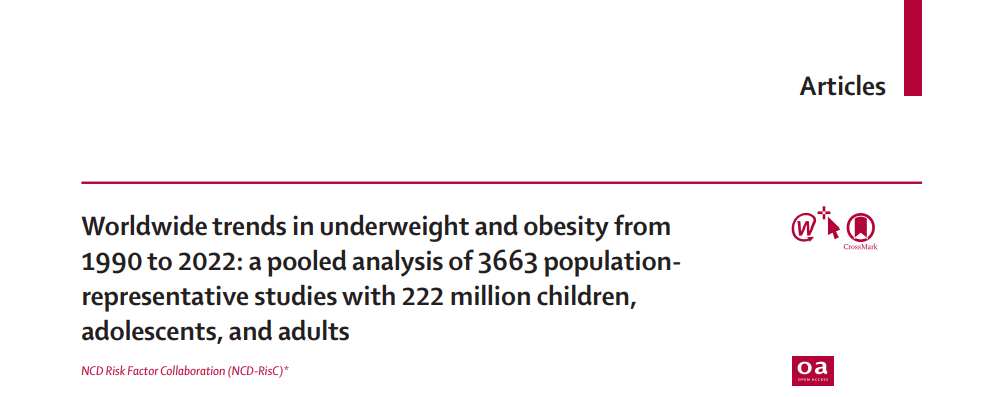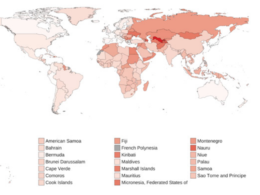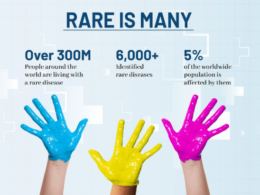health
transformation
portal
Joaquim Cardoso MSc
February 29, 2024
Geneva, 1 March 2024 — A new study released by the Lancet shows that, in 2022, more than 1 billion people in the world are now living with obesity. Worldwide, obesity among adults has more than doubled since 1990, and has quadrupled among children and adolescents (5 to 19 years of age). The data also show that 43% of adults were overweight in 2022.
The study also shows that even though the rates of undernutrition have dropped, it is still a public health challenge in many places, particularly in South-East Asia and sub-Saharan Africa.
Countries with the highest combined rates of underweight and obesity in 2022 were island nations in the Pacific and the Caribbean and those in the Middle East and North Africa.
Malnutrition, in all its forms, includes undernutrition (wasting, stunting, underweight), inadequate vitamins or minerals, overweight and obesity. Undernutrition is responsible for half of the deaths of children under 5 and obesity can cause noncommunicable diseases such as cardiovascular diseases, diabetes and some cancers.
WHO has contributed to the data collection and analysis of this study. The full dataset is now also disseminated through the Global Health Observatory.
“
This new study highlights the importance of preventing and managing obesity from early life to adulthood, through diet, physical activity, and adequate care, as needed,” said Dr Tedros Adhanom Ghebreyesus, WHO Director-General. “Getting back on track to meet the global targets for curbing obesity will take the work of governments and communities, supported by evidence-based policies from WHO and national public health agencies. Importantly, it requires the cooperation of the private sector, which must be accountable for the health impacts of their products”.
Obesity is a complex chronic disease. The causes are well understood, as are the interventions needed to contain the crisis, which are backed by strong evidence. However, they are not implemented. At the World Health Assembly in 2022 Member States adopted the WHO Acceleration plan to stop obesity, which supports country-level action through 2030. To date, 31 governments are now leading the way to curb the obesity epidemic by implementing the plan.
The core interventions are:
• actions to support healthy practices from day 1, including breastfeeding promotion, protection and support;
• regulations on the harmful marketing of food and beverages to children;
• school food and nutrition policies, including initiatives to regulate the sales of products high in fats, sugars and salt in proximity of schools;
• fiscal and pricing policies to promote healthy diets;
• nutrition labelling policies;
• public education and awareness campaigns for healthy diets and exercise;
• standards for physical activity in schools; and
• integration of obesity prevention and management services into primary health care.
“There are significant challenges in implementing policies aimed at ensuring affordable access to healthy diets for all and creating environments that promote physical activity and overall healthy lifestyles for everyone,” stated Dr Francesco Branca, Director of WHO’s Nutrition and Food Safety Department and one of the co-authors of the study. “Countries should also ensure that health systems integrate the prevention and management of obesity into the basic package of services.”
Addressing undernutrition requires multisectoral action in agriculture, social protection and health, to reduce food insecurity, improve access to clean water and sanitation and ensure universal access to essential nutrition interventions.

Worldwide trends in underweight and obesity from 1990 to 2022: a pooled analysis of 3663 populationrepresentative studies with 222 million children, adolescents, and adults
NCD Risk Factor Collaboration (NCD-RisC)*
Published Online February 29, 2024 https://doi.org/10.1016/ S0140–6736(23)02750–2
SeeOnline/Comment https://doi.org/10.1016/ S0140–6736(24)00051–5
*NCD-RisC members are listed at the end of the Article; affiliation details are provided in the appendix (pp 1–46)
Summary
Background
- Underweight and obesity are associated with adverse health outcomes throughout the life course.
- We estimated the individual and combined prevalence of underweight or thinness and obesity, and their changes, from 1990 to 2022 for adults and school-aged children and adolescents in 200 countries and territories.
Methods
- We used data from 3663 population-based studies with 222 million participants that measured height and weight in representative samples of the general population.
- We used a Bayesian hierarchical model to estimate trends in the prevalence of different BMI categories, separately for adults (age ≥20 years) and school-aged children and adolescents (age 5–19 years), from 1990 to 2022 for 200 countries and territories.
- For adults, we report the individual and combined prevalence of underweight (BMI 2 SD above the median).
Findings
- From 1990 to 2022, the combined prevalence of underweight and obesity in adults decreased in 11 countries (6%) for women and 17 (9%) for men with a posterior probability of at least 0·80 that the observed changes were true decreases.
- The combined prevalence increased in 162 countries (81%) for women and 140 countries (70%) for men with a posterior probability of at least 0·80.
- In 2022, the combined prevalence of underweight and obesity was highest in island nations in the Caribbean and Polynesia and Micronesia, and countries in the Middle East and north Africa.
- Obesity prevalence was higher than underweight with posterior probability of at least 0·80 in 177 countries (89%) for women and 145 (73%) for men in 2022, whereas the converse was true in 16 countries (8%) for women, and 39 (20%) for men.
- From 1990 to 2022, the combined prevalence of thinness and obesity decreased among girls in five countries (3%) and among boys in 15 countries (8%) with a posterior probability of at least 0·80, and increased among girls in 140 countries (70%) and boys in 137 countries (69%) with a posterior probability of at least 0·80.
- The countries with highest combined prevalence of thinness and obesity in school-aged children and adolescents in 2022 were in Polynesia and Micronesia and the Caribbean for both sexes, and Chile and Qatar for boys.
- Combined prevalence was also high in some countries in south Asia, such as India and Pakistan, where thinness remained prevalent despite having declined.
- In 2022, obesity in school-aged children and adolescents was more prevalent than thinness with a posterior probability of at least 0·80 among girls in 133 countries (67%) and boys in 125 countries (63%), whereas the converse was true in 35 countries (18%) and 42 countries (21%), respectively.
- In almost all countries for both adults and school-aged children and adolescents, the increases in double burden were driven by increases in obesity, and decreases in double burden by declining underweight or thinness.
Interpretation
- The combined burden of underweight and obesity has increased in most countries, driven by an increase in obesity, while underweight and thinness remain prevalent in south Asia and parts of Africa.
- A healthy nutrition transition that enhances access to nutritious foods is needed to address the remaining burden of underweight while curbing and reversing the increase in obesity.
A healthy nutrition transition that enhances access to nutritious foods is needed to address the remaining burden of underweight while curbing and reversing the increase in obesity.
Funding UK Medical Research Council, UK Research and Innovation (Research England), UK Research and Innovation (Innovate UK), and European Union.
For more on Sustainable Development Goal 2 see https:// www.un.org/ sustainabledevelopment/hunger
http://www.thelancet-press.com/embargo/malnutritiontrends.pdf












